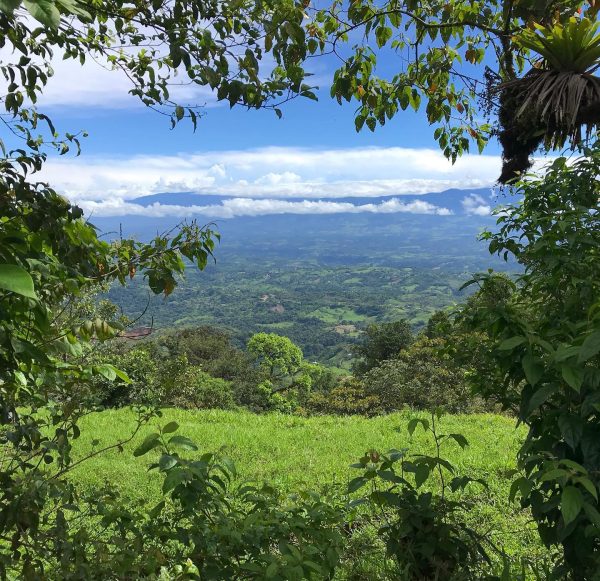
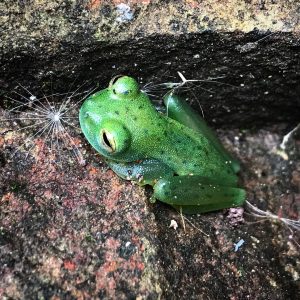
Complex patch geometries maximize species richness at the expense of forest specialists. The landscape surrounding Las Cruces Research Station is highly fragmented, consisting of forest reserves, forest patches, corridors, and a matrix. Clements et al. (2024)[1] found that species richness of amphibians and reptiles varied across habitats and were influenced by particular features, especially the presence of water. Patches of forest, corridors between patches and reserves, and forest reserves had similar richness and abundance of herpetofaunal species with the matrix habitat having low species richness. Patches with irregular shapes and greater edge had a high number of generalist species but low abundance and species richness of specialist indicator species of forest preserves. The authors underlined the importance of landscape considerations to optimize biodiversity conservation in diverse human-dominated landscapes.
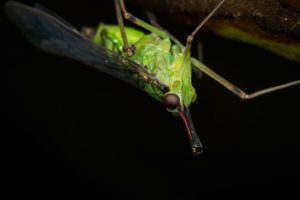
Friendly fungi: Tropical insect families form partnerships with intracellular fungi related to pathogens. Several large groups of insects (some Hemiptera and Homoptera) feed primarily on plant sap; but this diet is missing essential nutrients such as vitamins, amino acids, and sterols. To compensate, many of these insects have obligate partnerships with intracellular bacteria that synthesize and provide missing nutrients. One group, the planthoppers, associate with intracellular fungi that exist alongside or have replaced the ancient bacterial partners. Most previous studies on these relationships have been conducted in only a few temperate regions of the world. In a new paper, Siehl et al. (2024)[2] found that five tropical planthopper families host yeast-like endosymbionts related to the parasitic fungal genus Ophiocordyceps. Furthermore, the authors found a correspondence between the genetic identity of the fungal symbiont and the insect host family, suggesting possible coevolution of symbionts and insects. This study is the most comprehensive tropical planthopper-symbiont survey to date, doubling the known number of planthopper species that host intracellular fungi. Siehl et al. suggest that the diversity of symbiotic relationships may help explain the diversity and geographic abundance of the planthoppers.
Testing the Effectiveness of Synthetic Chemical Lures to Increase Fruit Bat-Mediated Seed Dispersal in a Tropical Forest. Assisted forest restoration, a tool for restoration of tropical forests, requires a method for moving seeds or young plants to the restoration site, such as encouraging the activities of seed-dispersing animals. Gelambi et al. (2024)[3] investigated a strategy to increase seed transport to degraded forest areas by using synthetic chemical lures to attract fruit bats and enhancing seed rain at La Selva Research Station. The lures were effective in increasing the number of several species of Carollia but had no detectable effect on activity by other fruit bats. During the experiment, the number of seeds collected in seed traps increased, but the effect of the lures did not explain the variance in seed rain. The authors suggest urge further study of synthetic lures to attract seed dispersers as cost-effective options for restoration initiatives. Read more in Mongabay, which recently featured this research in an article titled, “Lures that attract seed-dispersing bats could aid tropical reforestation.”
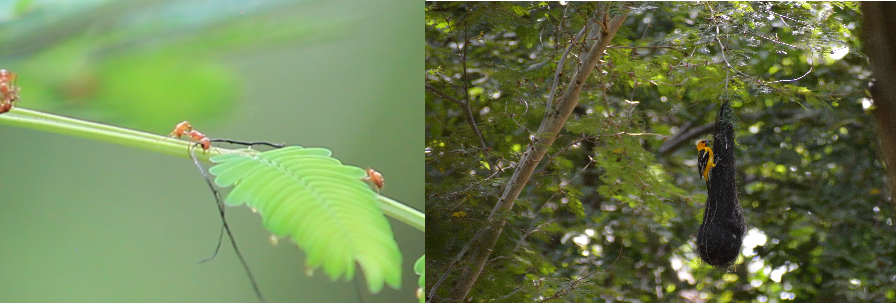
Horse-hair fungus used in bird nests alters the behavior of acacia ants. The iconic relationship between swollen thorn acacias (Vachellia) and the ants (Pseudomyrmex) that inhabit and defend the trees has been the subject of many studies at Palo Verde Research Station. Recently, Cortes-Romay and Amador Vargas[4] investigated how two bird species are able to nest in acacias despite the potential for repeated, vigorous stinging by ants of nestlings. The researchers studied the nests of two bird species that preferentially nest in acacias and construct nests entirely with fungal rhizomorphs (also known as mycelial cords, or special root-like structures found in fungi). In a series of experiments, they tested the behavior of acacia ants when contacting rhizomorphs versus control plant fibers and whether the presence of water altered ant behavior. Ants showed evidence of alarm, repellence, and intoxication after interaction with rhizomorphs, indicating that these fungal structures may function as a deterrent to ants. The authors suggest several lines of study that could be pursued from these findings.
Land-use changes around remnant savannas alter tree size demographics. As part of a long-term study on the effects of anthropogenic land-use change on subtropical and tropical savannahs, Mtsetfwa et al.[5] studied how two land uses (communal lands and intensive agricultural) affect the size class distributions of dominant large tree species (knobthorn [Senegalia nigrecens] and marula [Scelerocarya birrea]) in savannas patches. The abundance of marula was similar between savanna patches surrounded by savanna only and savannas surrounded both by agricultural and communal areas, while the abundance of most size classes of knobthorn was drastically reduced by surrounding land uses. The authors suggest that harvesting for fuel wood may be the explanation for the decrease in knobthorn abundance. The key finding from this study is that the effects of land use change on populations of large trees spills over from human-dominated landscapes to surrounding savannas. The authors suggest several management recommendations to increase large tree populations. Laurence Kruger, OTS Director of South Africa Programs, is an author on this study.
Differing Agents of Physical Damage to Artificial Seedlings in Remnant and Restored Forests. As part of a long-term study on forest restoration in the landscape near Las Cruces Research Station, Quirós Cedeño et al. (2025)[6] conducted an experiment with artificial seedlings to test of the role of physical damage in natural regeneration in tropical forests. After one year, more artificial seedlings had been damaged in restored forests compared to remnant forests, primarily due to greater frequency of woody debris falling from planted trees. Vertebrate damage was more common in remnant forests. The authors use their results to make specific recommendations related to forest restoration, such as planting a diverse set of cover species, considering characteristics of species planted with respect to debris fall, and conducting further research on the role of respective damage agents in determining the success of natural regeneration in forest restoration projects.
Indigenous Experiences and Contributions to Western Scientific Knowledge Systems: An Ethnographic Exploration. Esquete (2024)[7] conducted an interview-based study of the experience of students with a variety of Indigenous backgrounds participating in the OTS-led introduction to field ecology (NSF-Louis Stokes Alliance for Minority Participation Research Experience for Undergraduates). The author explored the ways that Native-born students in the program contributed innovations to the knowledge production process by shaping research questions, methodologies, and result interpretations.
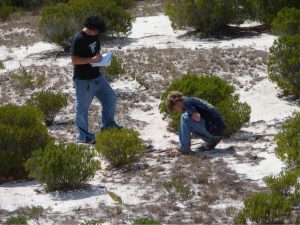
Adapting a Field Research Course to High School Biology: Twenty Years of Leading Teenagers to Do Science in the Woods. As an example of the far reach and long-lasting effects of an OTS course, Barry McPhail, a science teacher at the Alabama School of Mathematics and Science, adapted the OTS field teaching method to his high school courses[8]. In this article, McPhail emphasizes “the role of direct experiences in the living world in helping students understand biology and the practice of science, and in fostering a lifelong love for nature.” In this article, he provides details on how other teachers might adapt this curriculum, emphasizing the role of conducting research in developing student interest in science.
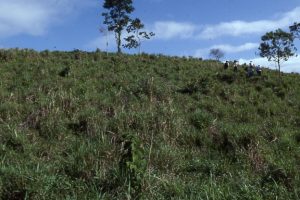
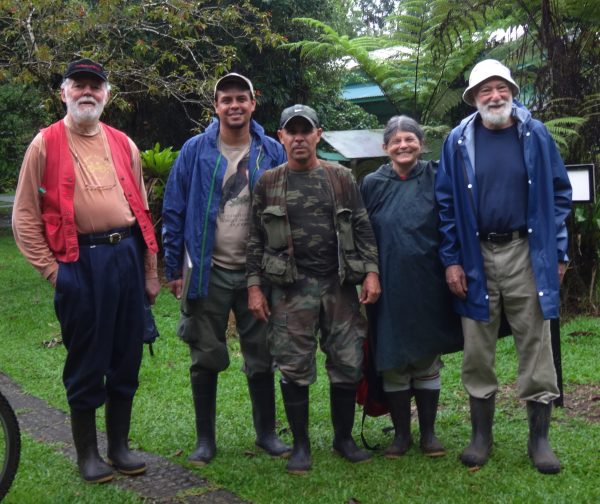
A Half Century of Tropical Forest Research: A Roadmap for the Future. This article highlights the importance of long-term research in understanding tropical forest dynamics and addressing climate change impacts. Gary Hartshorn, Diana Lieberman, and Milton Lieberman published a retrospective essay[11] describing the long-term PLOTS study. Permanent plots were established at La Selva in 1969 as a baseline for long-term research, with 6000 individuals of 260 tree species tagged and measured. Follow-up censuses were conducted in the 1980s and 1990s to re-measure, record mortality, and tag recruits. In 1985, the PLOTS project was expanded to include a large-scale elevational gradient, reaching from La Selva in the lowlands to the summit of the dormant Barva Volcano at 2,906 m, a distance of 35 km. The gradient passes through four life zones and two transitional zones of the Holdridge Life Zone system in Braulio Carrillo National Park. Over the last six years, with a monumental and collaborative effort, the La Selva plots and the Barva transect plots were re-censused, completing the 50-year inventory of the original plots and the 34-year inventory of the Barva transect. Among the principal findings are that diversity and canopy height were greatest at 300 m and lowest at 2,600 m. The inventories led to insights about the determinants of forest physical structure, diversity, life-form distribution, species composition, population structure, tree growth behavior, and forest dynamics. A total of 561 species in 91 families were mapped. Most species occurred within a narrow range of elevations along the transect, with approximately half of the total species found over a vertical range of 200 m or less. 16% of the species were found in a broader elevational range, up to 400 m. No species was found across the entire gradient, suggesting that the preponderance of species with narrow elevational ranges may increase their vulnerability to climate change. The authors recommended further conservation efforts and practical applications of these research findings, such as implementing assisted migration of at-risk species to higher elevations to mitigate climate change effects.
Braulio Carrillo National Park is one of only a few tropical protected areas that both extend over large elevational ranges and have been subject to baseline inventories. These areas provide critical data needed to examine the role of climate change in species distribution and abundance and to test hypotheses about lowland species attrition and upward or poleward range expansion (e.g. Colwell and Feeley 2025[12]).
Data sets and project details from the La Selva permanent plot inventories (1969–1995) are archived through the Environmental Data Initiative ensuring free, open access for scientific colleagues and the public. Apart from the importance of the impressive contribution of the works cited in the peer-reviewed literature, the publication of the PLOTS data and metadata on the EDI platform has additional significance. As the authors highlighted, there are two consummately critical considerations: 1) the data from long-term data repositories can be put in service to raise and answer questions that were not even considered when the study was started, and 2) the life spans of forests (and individual trees) far exceed the lifetime of individual researchers and grant cycles.
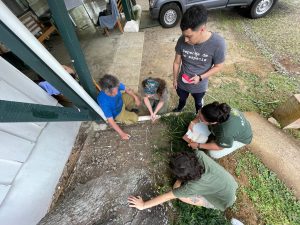
Neighbor Density and Post-Contact Immobility Duration as Antipredator Behavior: Antlion Larvae Do Not Fit the Selfish Prey Hypothesis. Larvae of some antlions (Neuroptera: Myrmeleontidae) build funnel-shaped pits as traps to capture small arthropod prey. While sit-and-wait hunting in the traps, antlion larvae are susceptible to predation by spiders, predatory beetles, and birds. Larvae may avoid predation either by escape (burying themselves) or by crypsis (being immobile). During the OTS graduate field course Ecología Tropical & Conservación (2024) at Las Cruces Research Station and Wilson Botanical Garden, Farji-Brenner et al. (2024)[13] studied predator-avoidance behavior of antlion larvae. The team posited that larvae living in a patch with a high density of conspecifics might be more likely than larvae with few neighbors to avoid predation by remaining immobile, allowing the predator’s attention to be drawn to other nearby prey (the “selfish prey hypothesis”). However, in field experiments, there was no relationship between the duration of post-contact immobility (PCI) by larvae and density of conspecifics, while in the lab, PCI duration by an individual larva was shorter than for the same individual in the field. These results did not support the selfish prey hypothesis, suggesting the need to look for alternative explanations for post-contact immobility, perhaps related to larval sensory abilities or the cost of escape.
[1] SL Clements, DV Alpízar, & CA Searcy (2024). Biotropica, 56, e13306. https://doi.org/10.1111/btp.13306
[2] R Siehl, K Vyhnal, & SK Goffredi (2024). iScience 27,110674. https://doi.org/10.1016/j.isci.2024.110674
[3] M Gelambi, YP Coto-Pereira, E Morales, & SR Whitehead (2025). Biotropica 57:e13426. https://doi.org/10.1111/btp.13426
[4] R Cortes-Romay & S Amador Vargas (2024). Animal Behaviour, 216 73e83. https://doi.org/10.1016/j.anbehav.2024.07.019
[5] FP Mtsetfwa, L Kruger, & RA McCleery (2025). Forest Ecology and Management 575 (2025) 122384. https://doi.org/10.1016/j.foreco.2024.122384
[6] GJ. Quirós Cedeño, FH Joyce, MA Zúñiga Amador & KD Holl (2025). Biotropica 57:e13421 https://doi.org/10.1111/btp.13421
[7] P Esquete Garrote (2024). Journal of Contemporary Ethnography 2024: 1-32. https://doi.org/10.1177/08912416241289609
[8] B McPhail (2024). The Science Teacher, 91:6, 20-31, DOI: 10.1080/00368555.2024.
https://doi.org/10.1080/00368555.2024.2402401
[9] AE.Russell, SJ Hall, R Bedoya, SN Kivlin, & CV Hawkes, 2024. Ecological Monographs, 2025;95:e1639. https://doi.org/10.1002/ecm.1639
[10] Bull Ecol Soc Am 0(0): e02222. https://doi.org/10.1002/bes2.2222
[11] G Hartshorn, D Lieberman, & M Lieberman, 2024. Forest History Today. 2023-2024, vol: 29&30: 88 – 97. https://foresthistory.org/wp-content/uploads/2025/01/FHT_2023-2024_Hartshorn_Liebermans_Tropical_Forestry.pdf
[12] RK Colwell & K Feeley (2025). Still little evidence of poleward range shifts in the tropics, but lowland biotic attrition may be underway. Biotropica, 57, e13358. https://doi.org/10.1111/btp.13358.
[13] AG Farji-Brener, A Abarca-Mendez, L Cubero-Morales, K Lopez-Reyes, D Ramirez-Mosquera, & I Escalante (2024). Ethology, 2024; 0:e13527 Ethology, 2024; 0:e13527
https://doi.org/10.1111/eth.13527
Banner photo: Stephanie Clements

